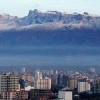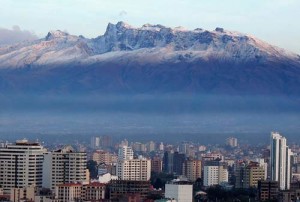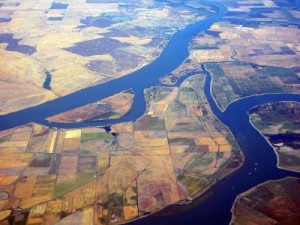
Challenging the Public/Private Dichotomy of Water Management
Cochabamba, Bolivia is famous for its 2000 “Water Wars”, in which a popular revolt successfully fought to throw out Bechtel Corporation and rejected the World Bank’s privatization scheme for urban water systems in the country. The Bechtel subsidiary had imposed dramatic price increases overnight that led to protests, which escalated and ultimately forced out the company. That successful uprising returned the water to the control of the state-run water system, but inefficiency and corruption continued to be a problem, despite efforts to increase social control and bring in “citizen representatives” to increase accountability (Shultz and Draper 2008, Ch. 1).

Downtown Cochabamba. During the ‘Water War’ protests, residents across the city were united in fighting the privatized system, despite different reasons for rejecting the new management and rate scheme. (photo source: Wikimedia Commons)
In the southern zone of the city, however, some of the city’s poorest communities had developed local systems to administer water that predated the Water Wars. These neighborhood-level cooperatives built the physical and governance infrastructure for entire water systems on a small scale. They dug wells, brought in piping, and connected homes to the grid. They organized into “asambleas,” which are councils that included the whole community in consensus decision-making. These cooperatives operate on a hyper-local scale and make up a small fraction of the population of the city. Of course, much remains to be desired for these communities’ access to and quality of water, especially compared to those parts of the city that receive adequate service from the public system (Bakker 2008). Nonetheless, they have challenged the state-run/privatized dichotomy (Ostrom 2010) that is prevalent in debates over water management, and have addressed shortcomings of both systems
Self-organization and Emergence in the Context of Managing Common Pool Resources
What are the behaviors and conditions that can lead to water management that is neither government-regulated nor privatized, but created from bottom-up organization? In complexity science, this process of bottom-up organization towards order is called emergence. Decentralized actions taken by a large number of water users can change the way that water management works, as in the example above, leading to a self-organizing system. Below, we explore how emergence and self-organization, two fundamental components of complex adaptive systems, can be used to better understand complex water management problems.
A self-organizing system in the context of complexity science suggests that the whole system is greater than the sum of its elements and their interactions. In this conceptualization, a system is a macro-level entity and an element is a micro-level entity. Simple rules at the micro level may lead to macro level patterns. Classic examples frequently come from biology (where self-organization tends to be the rule, rather than the exception.) For instance, ants (micro-level entity) follow simple rules for interacting with other ants in their immediate vicinity, and the cumulative effect of these simple behavioral rules is that they organize into colonies (macro-level pattern) that accomplish tasks, such as trailing, or building, that are beyond the capabilities and awareness of any individual members of the colony. One ant with these behaviors will not accomplish any of the ends that the colony achieves; the collective action of the ants that emerges is qualitatively distinct from any of their individual actions. This self-organization is adaptive, so evolutionarily these behaviors are selected to form in the population. The term “emergence” is used to describe how a self-organizing system forms. Emergence is the process by which lower-level interactions among elements integrate to form new levels of organization and pattern.
The principle of self-organization can be applied both descriptively and prescriptively (if we sufficiently understand the mechanisms by which self-organization occurs) to the management of shared resources such as water.
The Nobel prize-winning political economist Elinor Ostrom pioneered influential work applying the frameworks of complexity and self-organization to the challenge of managing common-pool resources. She argued in her work that communities that meet the conditions of a self-organizing system can (in some cases) avoid the “tragedy of the commons” (see Box 1). She challenged the classic model that “those who are involved in a Prisoner’s Dilemma game or other social dilemmas [are] always trapped in the situation without capabilities to change the structure themselves,” calling the paradox of individual rationality and collective “tragedy” that the game exemplifies a variable “empirical condition,” not a “logical universality” (Ostrom 2009b, 416). She also disputed the assumption of policy makers and policy analysts that to overcome this problem, governments would need to impose solutions, namely either regulation or privatization schemes, to change the “rules-in-use” for decision-making involving common resources.
Ostrom’s research highlighted a substantial subset of cases in which self-organizing systems developed to successfully manage common-pool resources. In these cases, the resource users themselves were able to overcome social and practical dilemmas of sharing a resource and devise effective governance strategies that users respected.
Idealized self-organizing systems have no central control; large-scale patterns emerge from small-scale rules. In reality, however, this is not always the case. Especially in socio-ecological systems, some top-down control structures such as environmental or market regulations may be present, but there is still room for bottom-up effects leading to the emergence of self-organizing phenomena. In fact, Ostrom found that in practice, the presence of certain community characteristics and institutional structures, including some measure of top-down regulation, can provide the external preconditions to catalyze self-organizing systems. The conditions that trigger self-organization may be external to the system. For example, the risk of severely reduced access to a resource by the threat of drastic regulation “from above” may spur a community to pursue other management options (as discussed below). However, the low-level rules that lead to the emergence of qualitatively distinct order on a higher scale are still generated within the lower levels (See box 2).
Self-Organization in California’s Water System
As might be expected, Ostrom found that self-organization occurs in communities where, among other factors, the transaction cost for organization is lower than the cost of doing nothing or abiding with top-down arrangements alone. What other factors contribute to self-organization taking place (or not taking place, when it seems like it might)?
In our first post of this series, we discussed some of the challenges to managing California’s scarce water amidst hotly contested claims to its use. Communities of users are responding to this problem in a variety of ways.
In one case, in the city of Porterville, though many residential wells have already been dry for more than a year, agricultural users are drilling more and deeper wells (in some cases, 10 times the depth of previous wells) to reach water that is disappearing from aquifers at an alarming rate. Despite the water shortage, market incentives encourage farmers to drill for as much water as they can reach to plant “wildly profitable” crops such as pistachios. As water becomes scarce, the effects of supply and demand make more profits for farmers who can continue to access enough water to cultivate these crops. Though the farmers are aware that this will ultimately be a self-defeating pattern, it does not show signs of changing. They are caught in the prisoner’s dilemma that Hardin described in “The Tragedy of the Commons.”
Water users farther north in the San Joaquin Delta face the same dilemma. Farmers with thirsty crops, fishermen and environmentalists demanding adherence to mandated protections for fisheries and wildlife, and other stakeholders battle for the scarce resource. In the Delta, though, fear that the government might cut off their taps entirely convinced a group of 500 farmers to voluntarily cut their water by 25% in exchange for the government’s assurance that it would not cut their water later. These farmers gave up their short-term interests, i.e. 25% of their profits, in exchange for the longer-term collective interest of predictability, and to avoid the risk of a more extreme cut later. This real-world collective effort possesses the major conditions of a self-organizing system:
- out of the simple actions of many separate micro level elements emerged a system that maintains its structure without much external control;
- the higher-order system possesses qualities—e.g., protection and predictability for the farmers—that would not be produced by any one of the individual actions by the farmers that made up the system. The macro-level pattern is not a mere sum of the micro-level framer’s actions.

The Sacramento-San Joaquin river delta is a 2800 sq. km inland delta that hosts protected estuaries, agricultural lands and urban settlements. (photo source: Wikimedia Commons)
Synthesis
The concepts of self-organization and emergence are particularly useful in analysis of complex water problems when the behaviors at the level of the system that we want to understand cannot be explained by the actions of individual agents or elements. A self-organizing system may be a desirable outcome for water governance, particularly when top-down governance is not effective, or when decision-making around collective interests is especially important.
A self-organizing system organizes in response to information and constraints at the local level, not from external direction, though the external environment may create the conditions for the system to self-organize. If we could understand these mechanisms, we might try to facilitate its emergence in a complex water system. However, because complexity in water systems is inherently contextual, specific prescriptions of how to initiate self-organization need to be contingent:
Just as a complex system is dynamic, the context in which it is likely to self-organize is highly changeable. It is not clear how (and under what conditions) individual actions turn into collective actions. Kenneth Arrow identified this uncertain nature of social choice actions in the mid 20th century. His theorem demonstrates the impossibility of pre-specification of collective outcomes based on individual preferences for some set of actions. Ostrom (2009a) illustrates how, despite the theoretical impossibility of solving these complex social choice problems, empirical evidence demonstrates that individual resource users can and do organize to create new institutional arrangements to manage common pool resources. Though Ostrom’s approach is rooted in rational choice theory, one of her primary contributions is to conceptualize and empirically verify the structural characteristics that enable, or hamper, self-organizational dynamics to manage common pool resources. Ostrom recognizes the interdependencies among elements, rules, configurations of rules, and response of variables, processes, actors and institutions. In her work, she offers a set of basic design principles found in these self-organizing systems. We briefly list these principles below to open a conversation around questions of how water managers can encourage self-organization to reframe and perhaps improve water management.
Ostrom (1990, 1993) found that the following attributes characterized long-enduring (self-organized) common-pool resource (CPR) institutions:
- Clearly defined boundaries [of both the service area and the individuals with rights to the resource]
- Proportional equivalence between benefits and costs [for users]
- Collective-choice arrangements [i.e., “most individuals affected by operational rules are included in the group who can modify these rules.”]
- Monitoring
- Graduated sanctions
- Conflict resolution mechanisms
- Minimal recognition of right to organize [i.e., “the rights of users to devise their own institutions are not challenged by external government authorities.”]
- Nested enterprises: governance activities are organized in multiple layers [for CPRs that are part of larger systems]
To encourage self-organizing behaviors, managers may find it helpful to facilitate the creation of these conditions. Even more generally, as the example above from the San Joaquin Delta in California illustrates, the burden of designing and implementing self-organization for users begins to look more feasible as the costs or risks of not doing so rise. Interestingly, both the presence of onerous regulation and the absence of sufficient regulation could lead to this cost/benefit analysis, suggesting that both hands-on and hands-off approaches of water managers could potentially lead to self-organizing outcomes. Finally, we might recall that in biology, self-organization is quite common at multiple scales, because it is adaptive—it is evolutionarily smart. Hopefully, self-organization of socio-ecological systems, including water systems, may possess similar adaptive characteristics. Therefore, any attempts to encourage self-organization to manage complex water problems ought to be contingent by leaving room for (and perhaps facilitating) institutional learning and adaptation in response to contextual conditions and larger environmental influences.
Bibliography
Bakker, Karen. 2008. “The Ambiguity of Community: Debating Alternatives to Private-Sector Provision of Urban Water Supply.” Water Alternatives 1 (2): 236–52.
Camazine, Scott, Jean-Louis Deneubourg, Nigel R. Franks, James Sneyd, Guy Theraulaz, and Eric Bonabeau. 2003. Self-Organization in Biological Systems. Princeton University Press.
Hardin, Garrett. 1968. “The Tragedy of the Commons.” Science, New Series, 162 (3859): 1243–48.
Ostrom, Elinor. 1990. Governing the Commons: The Evolution of Institutions for Collective Action. Cambridge University Press.
____. 1993. “Design Principles in Long-Enduring Irrigation Institutions.” Water Resources Research 29 (7): 1907–12. doi:10.1029/92WR02991.
____. 2009a. “Engaging Impossibilities and Possibilities.” In Arguments for a Better World: Essays in Honor of Amartya Sen, edited by Kaushik Basu and Ravi Kanbur, 522–41. New York: Oxford University Press.
____. 2009b. “Prize Lecture: Beyond Markets and States: Polycentric Governance of Complex Economic Systems.” presented at the The Sveriges Riksbank Prize in Economic Sciences in Memory of Alfred Nobel 2009, Stockholm, Sweden, December 8. http://www.nobelprize.org/nobel_prizes/economic-sciences/laureates/2009/ostrom-lecture.html.
____. 2010. “Beyond Markets and States: Polycentric Governance of Complex Economic Systems.” The American Economic Review 100 (3): 641–72.
Shultz, Jim, and Melissa Draper. 2008. Dignity and Defiance: Stories from Bolivia’s Challenge to Globalization. University of California Press.



